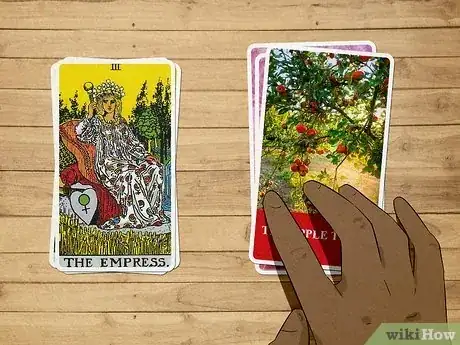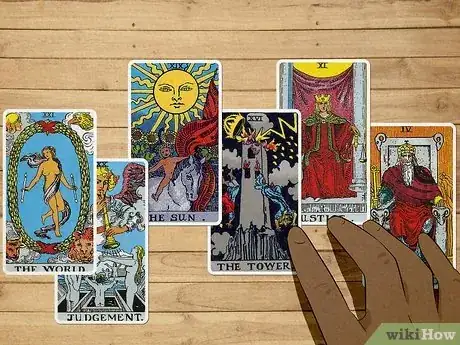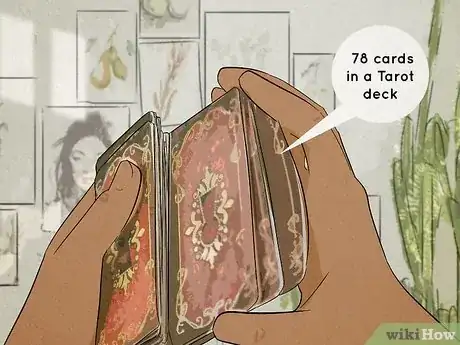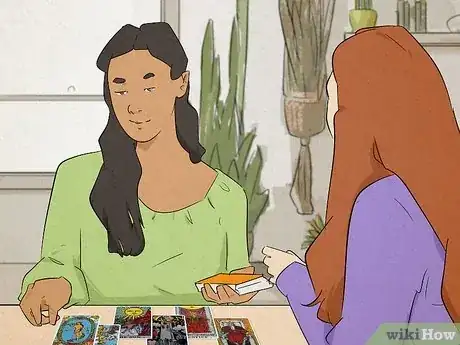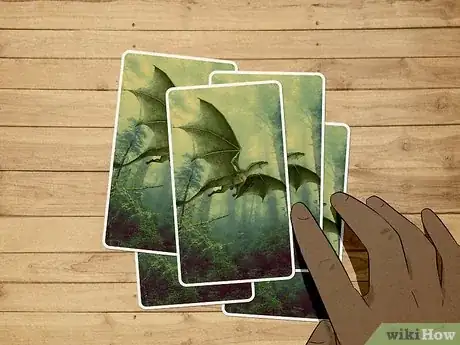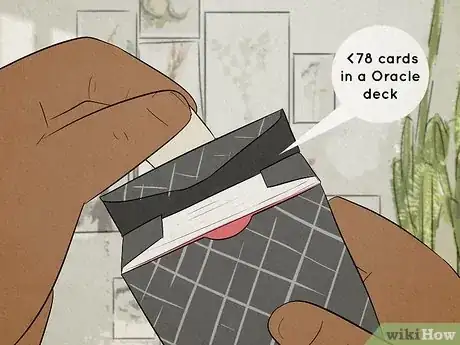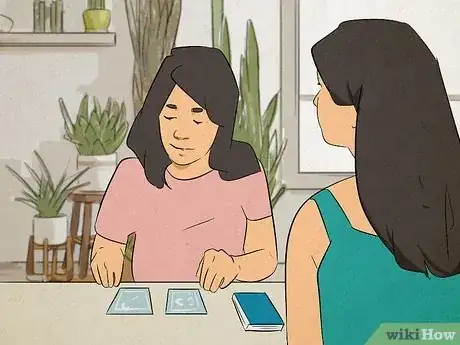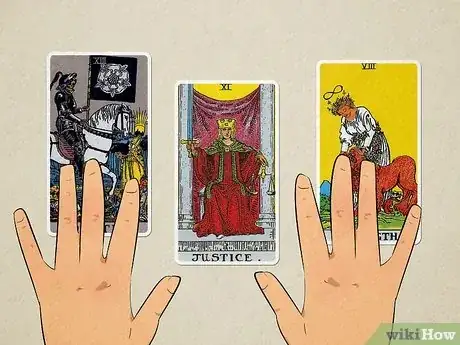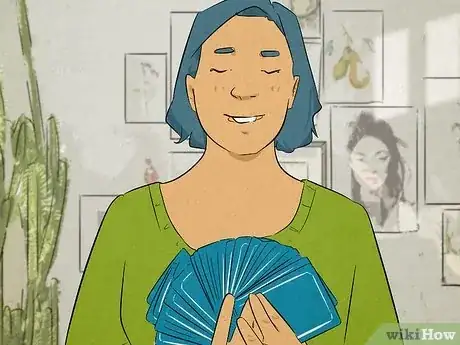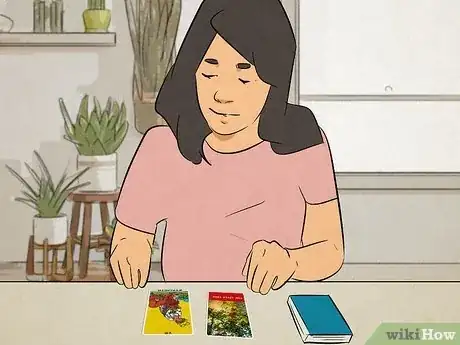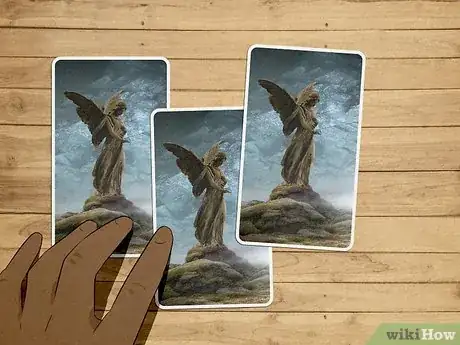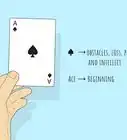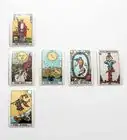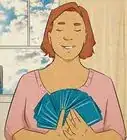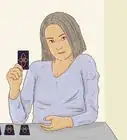This article was co-authored by Emily Christensen and by wikiHow staff writer, Aly Rusciano. Emily Christensen is a Shamanic Spiritual Advisor, Reiki Master, and the Founder of Rainbow Raaja based in Southern California and now King County, Washington. Emily has over six years of experience as a Massage Therapist and in using tarot cards, crystal therapy, light work (reiki, light codes, energy therapy), and shamanic healing. She received Reiki Master training from the Hands on Healing Institute. Emily is also a certified Bodywork Therapist by the California Massage Therapy Council and an Ordained Shamanic Minister with the Universal Life Church.
There are 9 references cited in this article, which can be found at the bottom of the page.
This article has been viewed 2,921 times.
You’re at your local metaphysical store, holding 2 decks of cards in your hands. In the left, a Tarot deck. In the right, an Oracle deck. Which do you choose? Are they both the same thing? Help! Well, the universe has brought you to the right place because this article will teach you everything you need to know about the differences between Tarot and Oracle cards. With our help, you’ll be a Tarot and Oracle card expert in no time!
Things You Should Know
- Tarot cards can have different imagery across decks, but the cards will always have very similar meanings.
- Oracle cards hold different themes, imagery, and meanings depending on the deck.
- While Tarot cards provide insight into pragmatic matters (and emotional ones), Oracle cards depict emotional challenges.
Steps
What’s the difference between Tarot and Oracle cards?
-
Tarot cards have universal meanings, whereas Oracle cards are free-flowing. Tarot is a pre-made system that almost always has the same number of cards and themes. Oracle, on the other hand, is dependent on the person who created them.[1] X Research source They both have unique art and images, but what they reveal within a reading differs.
- If you were to pick up 2 Tarot decks, the cards might look different, but they would have very similar meanings.
- If you picked up 2 Oracle decks, the cards would look different and have vastly different meanings.
Tarot Cards
-
1Tarot cards follow a set structure. These cards have incorporated astrology, numerology, and ancient symbolism for thousands of years.[2] X Research source Each deck holds the same themes, meanings, and principles so the reader can give accurate insights, no matter what deck they’re using.
- Although Tarot has an ancient history, it doesn’t have to be rigid! Using Tarot cards can be fun and creative.
-
2There are 78 cards in a Tarot deck. No matter what type of Tarot deck you pick up, it’ll have 78 cards and 2 types of cards: the Major Arcana and the Minor Arcana. This set amount of cards makes it easier to do accurate and detailed readings with any Tarot deck.[3] X Research source
- There are 22 Major Arcana cards in a deck. These cards represent the archetypes and depict major life influences and revelations.[4] X Research source
- There are 46 Minor Arcana cards divided into 4 suits. These cards refer to everyday matters and influences. Although the name of a deck’s suits can vary, they all represent the same thing.
-
3Tarot cards give a more personalized and detailed reading. There are positive and negative cards within a Tarot deck, just as there are positive and negative events in life. When you ask a Tarot deck a question, it’s more likely that you’ll receive a logical answer because there are several possible outcomes for any situation.
Oracle Cards
-
1Each Oracle deck has its own system. Unlike Tarot cards, Oracle cards can vary in meaning depending on who made them. Decks usually have general themes, and it’s up to the artist or creator to determine what each card represents.[5] X Research source
- For instance, a Camelot Oracle deck may have cards based on the characters from King Arthur, like Merlin, Lancelot, and Guinevere.
- These cards could represent specific archetypes like the hero or maiden, but they might also convey overall feelings of hope or grace, depending on the creator.
-
2Oracle decks usually have less than 78 cards. Typically, Oracle decks have around 35 and 60 cards, but this can vary based on the individual.[6] X Research source Because there are so few Oracle cards, they’re a bit easier to manage.
-
3It may be harder to get a detailed reading with Oracle cards. Many Oracle decks follow a specific mood or tone, which is why they’re often used as daily affirmation cards. Having a deck full of positive cards is a great morning boost, but these cards probably won’t give the most accurate responses to detailed questions.[7] X Research source
- For instance, say you ask a fairy-themed Oracle deck, “When will I get a raise?” and pull a fairy that conveys emotions of bliss and serenity. This card can’t tell you exactly when you’ll get a raise, but it can tell you how you may feel around that time.[8] X Research source
Which deck should you use?
-
1Use Tarot cards for more detailed readings. The mix of themes and quantity of cards in a Tarot deck make them perfect for gathering insight on the future. A Tarot reading is far more detailed than an Oracle reading, as more concrete results can be given. So, if you’re looking for an answer to a specific question, stick with Tarot cards.
-
2Try Oracle cards if you’re just starting your divination practice. An Oracle reading is all about interpretation, thanks to the deck’s free-flowing structure. Unlike Tarot cards, there are no set meanings or themes to memorize. Instead, you can follow you own intuition and interpret the cards however you like.
- If you’re a beginner and gravitate more toward Tarot, pick up a Tarot deck instead! There are no rules on what you have to do—follow you heart and choose a deck that best fits your needs.
-
3Use Tarot and Oracle cards together for a deeper reading. Who says you only have to use one type of deck? One of the many beautiful things about a divination practice is that it can be personalized. Pull an Oracle card to understand the overall tone, mood, or emotion, and then draw Tarot cards to identify key events or points of influence.[9] X Research source
- Play around with your decks to create more and more layers in your readings.
- Use whichever deck you feel drawn to during a reading.
- Lay out your cards or create spreads based on how you feel and what you can visualize.
Are Angel cards the same as Oracle cards?
-
Yes, Angel cards are a type of Oracle deck. Unlike Tarot cards, Angel cards don’t offer specific insights into the future. Instead, they provide emotional and spiritual guidance.
- An Angel card’s interpretation is up to the creator and reader, as they follow a free-flowing structure.
You Might Also Like
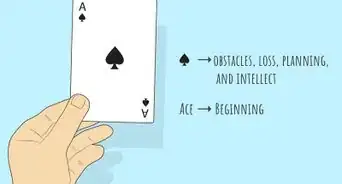
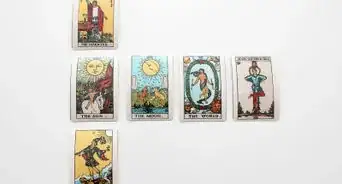
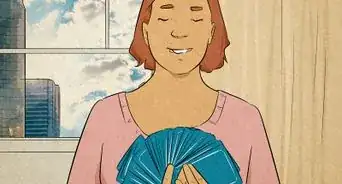 8 Ways to Cleanse Tarot Cards & When To Do It
8 Ways to Cleanse Tarot Cards & When To Do It
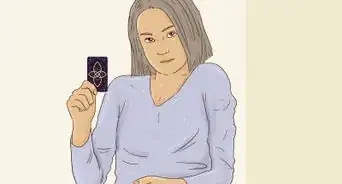
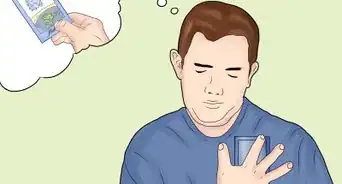
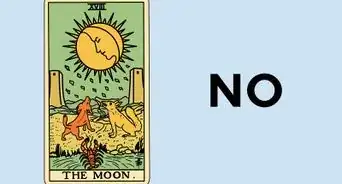 Moon Tarot Card Meaning: Upright, Reversed, and More
Moon Tarot Card Meaning: Upright, Reversed, and More
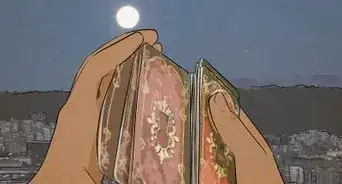 How to Use Oracle Cards
How to Use Oracle Cards
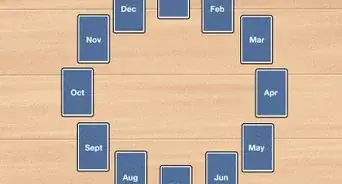
References
- ↑ https://youtu.be/Ij2sNYmsIdQ?t=694
- ↑ https://youtu.be/vyCMuk3msVQ?t=56
- ↑ https://youtu.be/Ij2sNYmsIdQ?t=100
- ↑ https://www.thecut.com/article/tarot-cards.html
- ↑ https://youtu.be/Ij2sNYmsIdQ?t=487
- ↑ https://youtu.be/Ij2sNYmsIdQ?t=657
- ↑ https://youtu.be/Ij2sNYmsIdQ?t=628
- ↑ https://youtu.be/vyCMuk3msVQ?t=109
- ↑ https://youtu.be/NEeRnsF0F9c?t=1
About This Article

